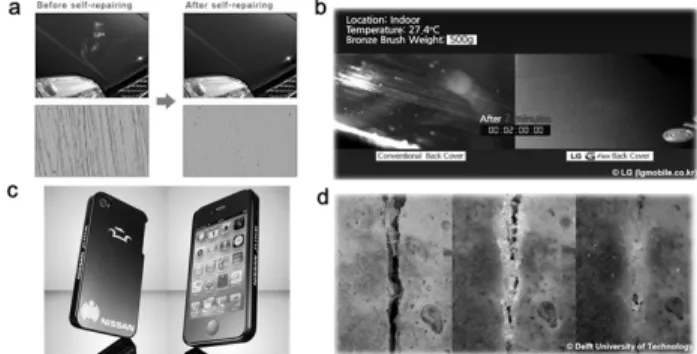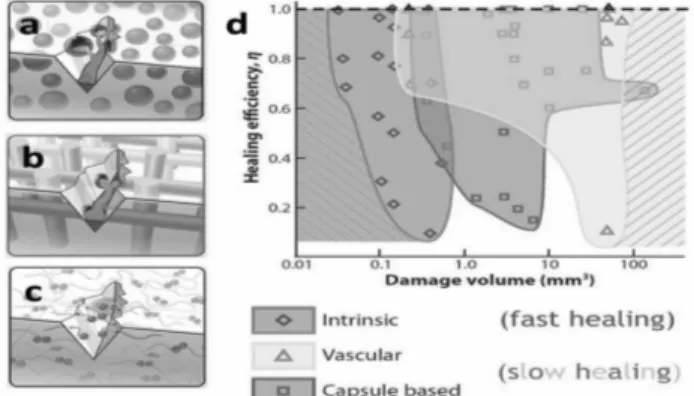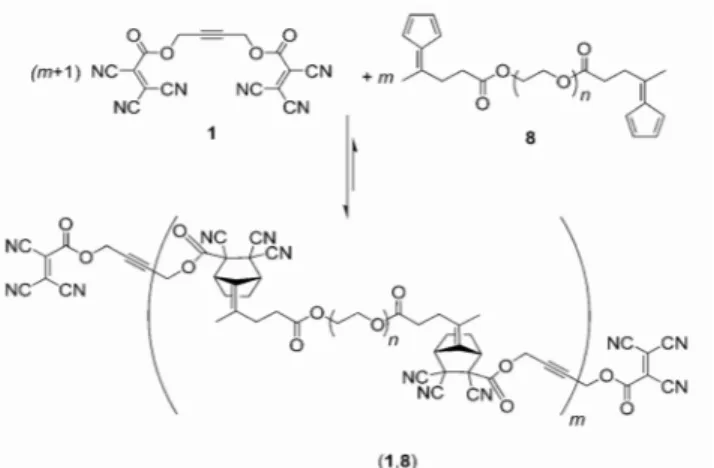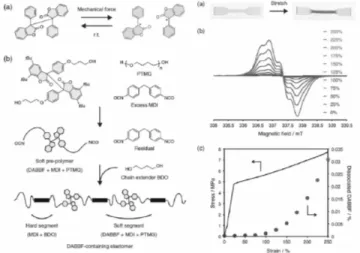1. 기술의 정의 및 분류 5)
현재까지 고분자 코팅은 특정 기재 표면을 외부환경 으로부터 보호하고 심미적 외관을 향상시키는 목적으 로 주로 이용되어 왔으나 최근에는 자기치유, 자기세 정, 자극–응답, 저온경화 등과 같은 다양한 스마트 기 능을 수행하는 방향으로 진화되고 있다[1,2]. 그 중에서 스마트 자기치유 코팅 기술은 수송기기, 건축⋅공업, 의료 및 전기정보전자 등의 고부가가치 제품에 응용될 수 있는 차세대 코팅 기술로 학계 및 산업계의 큰 관심 을 받고 있다 (Figure 1)[3–6].
스마트 자기치유 코팅 기술에 적용되는 주요 메커니 즘으로는 외인성 자기치유 시스템 (extrinsic self-healing system) 및 내인성 자기치유 시스템 (intrinsic self-healing system)으로 분류된다. 외인성 자기치유 시스템은 액상 의 자기치유 물질을 함유하는 마이크로 캡슐을 코팅 층에 분산시킨 형태로 물리적 충격으로 인해 코팅 층 이 손상을 입었을 경우 마이크로 캡슐이 파괴되면서 자가치유 물질이 방출된 후 경화됨으로써 손상을 치유 하는 방식이다[7–9]. 외인성 자기치유 시스템은 넓은 면적의 손상 부위를 자기 치유할 수 있다는 점에서 큰 이점을 가지고 있으나 마이크로캡슐의 제조 공정이 복 잡하여 소재의 대량 생산이 용이하지 않고, 코팅 바인 더와 마이크로캡슐 간 굴절률 차로 인한 광 난반사 현 상 (haze)으로 인해 투명한 코팅 층을 제조하기 어렵다.
또한 자기치유 현상이 마이크로캡슐의 붕괴에 의해 일 어나기 때문에 일회성 자기치유만을 제공할 수 있고 물리적⋅화학적 내구성을 보유한 마이크로캡슐 제조 가 용이하지 않아 내구성과 투명성을 동시에 요구하는 수송기기 코팅 분야 등에서는 그 사용이 매우 제한된 다. 이에 반해, 내인성 자기치유 코팅 시스템은 코팅
소재에 i) 수소결합 (hydrogen bonding) 및 전하-이동 복 합체 (charge transfer complex) 등의 물리적 상호 작용, ii) 가역적 촉매 반응 (catalytic reaction), iii) 디엘스 알 더-역디엘스 알더 반응 (Diels Alder (DA)/retro-Diels Alder (r-DA) reaction),[10-14] 및 힌더드 유레아 결합 (hindered urea bond),[15-17] 알콕시 아민 (alkoxy amine),[18,19] 보로닉 에스터 (boronic ester), 디-설파이 드 결합 (di-sulfide bond) 등 다양한 동적가교시스템 (dynamic crosslinking system)[20-24]을 도입하여 자기 치유 소재를 제조하는 기술로서 외인성 자기치유 시스 템과는 달리 다회성 자기치유가 가능하다는 점과 투명 한 코팅 층도 제조할 수 있다는 점에서 산업계의 큰 주목을 받고 있다. 그러나 내인성 자기치유 시스템은 메커니즘 상 높은 유동성을 지닌 고분자 구조를 요하 므로 단단한 코팅 층을 제조하는 데에는 한계가 있어 상용화를 위해서는 아직 많은 연구가 필요하다. Table 1., Figure 2. 및 Figure 3.은 외인성 및 내인성 자기치유 코팅 시스템의 종류, 장⋅단점 및 특성을 나타낸다.
Figure 1. Applications of self-healing materials: (a) self-healing clearcoat (Nissan, Scratch Shield), (b) self-healing mobile phone and (c) mobile phone protection case (d) self-healing concrete.
†Corresponding author: Jin Chul Kim (jckim81@krict.re.kr), Seung Man Noh (smnoh@krict.re.kr)
http://dx.doi.org/10.17702/jai.2018.19.1.30
스마트 자기치유 코팅 기술 동향
김진철†⋅박영일⋅이상호⋅노승만† 한국화학연구원 그린정밀화학연구센터
Recent Advances in Smart Self-healing Coatings
Jin Chul Kim†⋅Young Il Park⋅Sang-Ho Lee and Seung Man Noh† KRICT, 45, Jong-ga Ro, Joong Gu, Ulsan, 44412, Republic of Korea
(2018년 3월 2일 접수)
2. 폴리도파민의 화학
스마트 자기치유 코팅 기술의 상용화를 위해서는 다 음과 같은 특성이 요구된다.
2.1. 다회성 스마트 자기치유 코팅 기술
스마트 자기치유 코팅 기술의 상업화를 위해서는 손 상에 대한 반복적이고 지속적인 자기치유 능력이 요구 된다.
2.2. 무색⋅투명 소재 기반 스마트 자기치유 코팅 기술 구현 수송기기, 전자제품 등의 산업 분야에 사용되는 코 팅 소재는 제품 보호뿐만 아니라 제품 외관을 향상시 키는 용도로 이용되기 때문에 무색이면서 투명성이 보 장된 자기치유 코팅 시스템의 개발이 요구된다.
2.3. 높은 경제성과 공정성을 확보할 수 있는 스마트 자기치 유 코팅 기술
스마트 자기치유 코팅 기술의 상업화를 위해서는 기 존 공정에서 추가적인 코팅 공정 없이 양산화할 수 있 어야 한다. 생산 라인 프로세스 별 코팅 윈도우를 제어 하기 위해서는 소재의 개발뿐만 아니라 소재가 가지고 있는 유변학적 특성을 잘 이해해야 할 필요가 있다.
2.4. 물리적⋅화학적 내구력을 보유한 스마트 자기치유 코팅 기술
수송기기, 건설⋅공업 등의 산업 분야에 사용되는 코팅 소재는 외부 환경에 장기간 노출되므로 높은 물 리적⋅화학적 내구력을 보유하 면서도 자기치유 특성 이 뛰어난 소재의 개발이 필요하다.
2.5. 자극-응답 코팅 소재와 연동된 자기치유 코팅 기술 자기치유 성능과 더불어 코팅 층의 손상 여부를 자 기 보고하는 코팅 소재 (self-reporting material)가 많은 산업 분야에서 요구된다.
Figure 3. Demonstration of self-healing with a) capsule-based, b) vascular-based, and c) intrinsic polymers. d) Performance map for self-healing materials. Each polymer has demonstrated healing for different volumes of damage [25].
3. 스마트 자기치유 코팅 최근 기술 동향
Figure 4. Thermally reversible self-healing polymer network based on Diels–Alder chemistry.
Figure 2. Extrinsic and intrinsic self-healing mechanisms.
Figure 5. Influence of material properties on scratch-healing performance of polyacrylate-graft-polyurethane network that undergo thermally reversible crosslinking.
3.1. 동적 공유 결합 (dynamic covalent bond) 을 응용한 가역성 고분자 네트워크
3.1.1. DA/rDA 반응을 활용한 열가역성 고분자 네트워크 (Thermally Reversible Poly-mer Network)
열 가역 DA/rDA 반응 시스템을 기반으로 하는 내인 성 자기치유 고분자는 투명하고 무색이며 내구성이 뛰 어난 코팅을 제조할 수 있다는 점에서 많은 연구가 이 루어지고 있다. 현재까지 가장 많이 응용되고 있는 디 엔 (diene)과 디엔오파일 (dieneophile)은 퓨란 (furan)과 말레이미드 (maleimide) 유도체로 약 100∼120℃ 영역 에서 rDA 반응이 일어나고, 상온∼70℃ 영역에서 DA 반응이 일어난다(Figure 4.).
본 시스템에서 자기치유 성능은 고분자 네트워크가 해체되었을 때의 고분자 사슬의 유동성에 크게 의존하 기 때문에 코팅 물성과 자기치유 성능과의 균형을 유 지할 수 있는 고분자 시스템 개발이 요구되며 이에 대 한 정량 분석 기법 또한 매우 중요하다. 최근 한국화학 연구원에서는 다양한 사슬 길이를 가지는 그래프트 고 분자 네트워크 (graft polymer network)를 이용한 DA/rDA 반응 기반 자기치유 시스템을 개발하고 고분 자 물성-자기치유 특성 간 상관 관계를 규명하는 연구 를 진행한 바 있다(Figure 5)[26].
본 시스템의 본격적인 상용화를 위해서는 퓨란 및 말레이미드 시스템보다 더 낮은 온도에서 동적 공유결 합을 구현할 수 있는 기술 개발이 요구된다. 프랑스 Strasbourg 대학 Lehn 교수 연구팀에서 상온 DA/rDA 반응 기반 가역성 고분자 네트워크를 구현한 예가 있 으나 아직까지 이에 대한 연구는 많이 이루어지지 않 았다(Figure 6.)[27].
3.1.2. 힌더드 유레아 기반 가역 고분자 네트 워크 시스템 힌더드 유레아 기반 가역 고분자 네트워크시스템은 가역 고분자 네트워크 기술이라는 점에서는 DA/rDA 반응 기반 고분자 네트워크 시스템과 유사하나 네트워 크의 형성과 해리가 동적 평형 상태에 있다는 점에서 큰 차이점을 보인다. 미국 일리노이대학 Cheng 교수 연구팀에서 본 기술을 학계에 보고한 이후 현재까지 자기치유 고분자 분야에서 가장 활발히 연구가 진행되 는 기술 중 하나이다(Figure 7.)[15-17].
힌더드 유레아 기반 가역 고분자 네트워크 시스템은 이소시아네이트 (isocyanate)와 2 차 아민 간 반응으로 기존 폴리우레탄 (polyurethane) 기반 코팅 시스템에 즉 시 적용이 가능하고 상온 자기치유 시스템이므로 수송 기기, 전자제품 및 의료기기 등 폭넓은 분야에 응용이 가능하다. 특히, 본 자기치유 시스템은 높은 자기치유 성능과 기계적 물성을 동시에 확보할 수 있는 기술로 상용화 가능성이 매우 높은 것으로 알려져 있다 (Figure 8.)[28]. 최근 경북대학교에서는 힌더드 유레아 기반 자기치유 소재를 사용하여 자기치유 튜브를 제조 하는 연구를 진행한 바 있다(Figure 9.)[29].
Figure 6. Room temperature dynamic polymers based on Diels–Alder chemistry.
Figure 7. Self-healing polymer network based on dynamic hindered urea bond.
3.2. 자극-응답 코팅 소재와 연동된 자기치유 코팅 기술
3.2.1. 메카노포어 (Mechanophore) 기반 고분 자 네트워크 시스템
메카노포어 기반 고분자 네트워크 시스템은 물리적 자극에 의해 동적 공유 결합이 해체되었다가 재생될 수 있는 자극-응답형 분자로 정의된다. 메카노포어 기 반 자기치유 시스템은 동경공대 Hideyuki 교수 연구팀 이 선두그룹으로 그의 연구팀에서는 디아릴바이벤조 퓨라논 (Diarylbibenzofuranone, DABBF) 그룹을 사용하 여 메카노포어 기반 자기치유 시스템을 구현하였다.
본 기술의 우수성은 무색⋅투명한 소재를 구현하였을 뿐만 아니라 소재의 손상과 자기치유 여부를 소재 색 깔의 변화를 통하여 인지할 수 있다는 점에 있다 (Figure 10.)[30,31].
3.2.2. 응집 유도 발광 (Aggregation Induced Emission, AIE) 기반 자기치유 코팅 시스템
응집 유도 발광은 특정 유기발광체에서 관찰되는 특 이현상으로 일반적인 유기발광체 분자와는 달리 용액 상에서보다 고체 상에서 더 높은 양자효율(Quantum Yield)를 보인다. 최근 한국화학연구원에서는 응집 유
도발광 물질인 테트라페닐에탄 (tetraphenylethene, TPE) 및 광경화형 단량체, 광개시제를 마이크로캡슐에 집적화시켜 코팅 층의 균열을 감지할 수 있는 외인성 자기치유 코팅 소재를 개발하여 학계에 보고한 바 있 다 (Figure 11.)[8]. 본 기술은 유해화학물질 저장 용기 또는 물질 이송파이프등에 적용된 금속 및 다양한 기 재의 손상을 미리 모니터링 할 수 있고, 더불어 코팅 소재의 손상으로 발생하는 금속 소재의 부식이나 미세 크랙 (crack)을 진단할 수 있는 자기치유-자기보고 시 스템으로 사용될 수 있다.
4. 결 론
스마트 자기치유 코팅 기술은 고분자 기반의 코팅 소재 기술의 차세대 주력 분야로 학계와 산업계에서 매우 관심이 높은 기술 분야이다. 스마트 자기치유 기 Figure 11. Fluorescence Detection of Microcapsule Type Self‐Healing, Based on Aggregation‐Induced Emission.
hindered urea bond.
Figure 9. Water-adaptive and repeatable self-healing polymers bearing bulky urea bonds.
Figure 10. Self-healing polymer network based on DABBF.
술의 본격적인 상용화를 위해서는 물리적⋅화학적 내 구성과 높은 자기치유 성능을 동시에 보유할 수 있는 새로운 자기치유 시스템의 개발이 필요한 상황으로 향 후 상당한 기술적 가치를 제공해줄 것으로 전망된다.
References
1. S.B. Ulaeto, R. Rajan, J.K. Pancrecious, T.P.D.
Rajan, B.C. Pai, Developments in smart anticorrosive coatings with multifunctional characteristics, Prog.
Org. Coat. 111 (2017) 294–314. doi:10.1016/j.porg coat.2017.06.013.
2. V. Anand Ganesh, H. Kumar Raut, A. Sreekumaran Nair, S. Ramakrishna, A review on self-cleaning coatings, J. Mater. Chem. 21 (2011) 16304–16322.
doi:10.1039/C1JM12523K.
3. K. Urdl, A. Kandelbauer, W. Kern, U. Müller, M.
Thebault, E. Zikulnig-Rusch, Self-healing of densely crosslinked thermoset polymers—a critical review, Prog. Org. Coat. 104 (2017) 232–249. doi:10.1016/
j.porgcoat.2016.11.010.
4. D.G. Bekas, K. Tsirka, D. Baltzis, A.S. Paipetis, Self-healing materials: A review of advances in materials, evaluation, characterization and monitoring techniques, Compos. Part B Eng. 87 (2016) 92–119.
doi:10.1016/j.compositesb.2015.09.057.
5. Z. Wei, J. Hai Yang, J. Zhou, F. Xu, M. Zrínyi, P.
H. Dussault, Y. Osada, Y. Mei Chen, Self-healing gels based on constitutional dynamic chemistry and their potential applications, Chem. Soc. Rev. 43 (2014) 8114–8131. doi:10.1039/C4CS00219A.
6. L. Zedler, M.D. Hager, U.S. Schubert, M.J.
Harrington, M. Schmitt, J. Popp, B. Dietzek, Monitoring the chemistry of self-healing by vibrational spectroscopy – current state and perspectives, Mater. Today. 17 (2014) 57–69.
doi:10.1016/j.mattod.2014.01.020.
7. S.H. Cho, S.R. White, P.V. Braun, Self-Healing Polymer Coatings, Adv. Mater. 21 (2009) 645–649.
doi:10.1002/adma.200802008.
8. Y. K. Song, B. Kim, T. H. Lee, J. C. Kim, J. H.
Nam, S. M. Noh, Y. I. Park, Fluorescence Detection of Microcapsule-Type Self-Healing, Based on Aggregation-Induced Emission, Macromol. Rapid Commun. 38 (2017) n/a-n/a. doi:10.1002/marc.2016 00657.
9. Y.K. Song, B. Kim, T.H. Lee, S.Y. Kim, J.C. Kim, S.M. Noh, Y.I. Park, Monitoring Fluorescence Colors to Separately Identify Cracks and Healed Cracks in Microcapsule-containing Self-Healing Coating, Sens. Actuators B Chem. (2017). doi:10.1016/
j.snb.2017.11.019.
10. J. Bai, H. Li, Z. Shi, J. Yin, An Eco-Friendly Scheme for the Cross-Linked Polybutadiene Elastomer via Thiol–Ene and Diels–Alder Click Chemistry, Macromolecules. 48 (2015) 3539–3546.
doi:10.1021/acs.macromol.5b00389.
11. C. Goussé, A. Gandini, P. Hodge, Application of the Diels−Alder Reaction to Polymers Bearing Furan Moieties. 2. Diels−Alder and Retro-Diels−Alder Reactions Involving Furan Rings in Some Styrene Copolymers, Macromolecules. 31 (1998) 314–321.
doi:10.1021/ma9710141.
12. Y. Chujo, K. Sada, T. Saegusa, Reversible gelation of polyoxazoline by means of Diels-Alder reaction, Macromolecules. 23 (1990) 2636–2641. doi:10.1021/
ma00212a007.
13. Y.-L. Liu, T.-W. Chuo, Self-healing polymers based on thermally reversible Diels–Alder chemistry, Polym. Chem. 4 (2013) 2194–2205. doi:10.1039/
C2PY20957H.
14. S.A. Canary, M.P. Stevens, Thermally reversible crosslinking of polystyrene via the furan–maleimide Diels–Alder reaction, J. Polym. Sci. Part Polym.
Chem. 30 (1992) 1755–1760. doi:10.1002/pola.
1992.080300829.
15. H. Ying, Y. Zhang, J. Cheng, Dynamic urea bond for the design of reversible and self-healing polymers, Nat Commun. 5 (2014) 3218-3226. doi:
10.1038/ncomms4218.
16. H. Ying, J. Cheng, Hydrolyzable Polyureas Bearing Hindered Urea Bonds, J. Am. Chem. Soc. 136 (2014) 16974–16977. doi:10.1021/ja5093437.
17. Y. Zhang, H. Ying, K.R. Hart, Y. Wu, A.J. Hsu, A.M. Coppola, T.A. Kim, K. Yang, N.R. Sottos, S.R. White, J. Cheng, Malleable and Recyclable Poly(urea-urethane) Thermosets bearing Hindered Urea Bonds, Adv. Mater. 28 (2016) 7646–7651.
doi:10.1002/adma.201601242.
18. Z.P. Zhang, M.Z. Rong, M.Q. Zhang, C.’e Yuan, Alkoxyamine with reduced homolysis temperature and its application in repeated autonomous self-healing of stiff polymers, Polym. Chem. 4 (2013) 4648–4654. doi:10.1039/C3PY00679D.
19. C. Yuan, M.Z. Rong, M.Q. Zhang, Z.P. Zhang, Y.C.
Yuan, Self-Healing of Polymers via Synchronous Covalent Bond Fission/Radical Recombination, Chem. Mater. 23 (2011) 5076–5081. doi:10.1021/
cm202635w.
20. Z. Wei, J. Hai Yang, J. Zhou, F. Xu, M. Zrínyi, P.
H. Dussault, Y. Osada, Y. Mei Chen, Self-healing gels based on constitutional dynamic chemistry and their potential applications, Chem. Soc. Rev. 43 (2014) 8114–8131. doi:10.1039/C4CS00219A.
21. S.Y. An, S.M. Noh, J.H. Nam, J.K. Oh, Dual
on Thiol–Disulfide Exchange Reactions and Self-Healing Kinetics Measured Using Atomic Force Microscopy, Macromolecules. 45 (2012) 142–
149. doi:10.1021/ma2015134.
24. M. Pepels, I. Filot, B. Klumperman, H. Goossens, Self-healing systems based on disulfide – thiol exchange reactions, Polym. Chem. 4 (2013) 4955–
4965. doi:10.1039/C3PY00087G.
25. T.-P. Huynh, P. Sonar, and H. Haick, Advanced Materials for Use in Soft Self-Healing Devices, Adv. Mater. 29 (2017) 1604973-160486. doi:
10.1002/adma.201604973.
26. S. Y. Kim, T. H. Lee, Y. I. Park, J. H. Nam, S. M.
Noh, I. W. Cheong, J. C. Kim, Influence of material properties on scratch-healing performance of polyacrylate-graft-polyurethane network that undergo thermally reversible crosslinking, Polymer 128 (2017)
29. J. I. Park, A. Choe, M. P. Kim, H. Ko, T. H. Lee, S. M. Noh, J. C. Kim, I. W. Cheong, Water-adaptive and repeatable self-healing polymers bearing bulky urea bonds, Polymer Chemistry, 9 (2018) 11-19.
doi: 10.1039/C7PY01655G.
30. K. Imato, M. Nishihara, T. Kanehara, Y. Amamoto, A. Takahara, H. Otsuka, Self-Healing of Chemical Gels Cross-Linked by Diarylbibenzofuranone-Based Trigger-Free Dynamic Covalent Bonds at Room Temperature, Angew. Chem. Int. Ed., 51 (2012) 1138 –1142. doi: 10.1002/anie.201104069.
31. K. Imato, T. Kanehar, S. Nojima, T. Ohishi, Y.
Higaki, A. Takahara and H. Otsuka, Repeatable mechanochemical activation of dynamic covalent bonds in thermoplastic elastomers, Chem.
Commun., 52 (2016) 10482-10485. doi:
10.1039/c6cc04767j.



